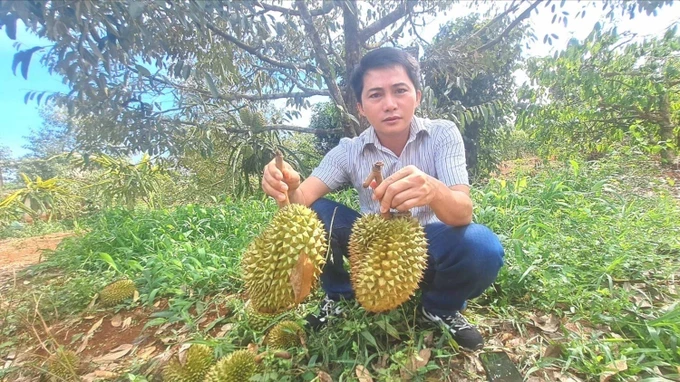
Dak Lak Province now has about 32,000ha of durian orchards. After intense heat from the beginning of this year, in May, there has been some rain in the province. That did not help durian trees much; on the contrary, it caused the trees to lose their young fruits. Farmer Mai Van Hung from Quang Tien Commune of Cu M’gar District reported that for the last 10 days, the phenomenon has happened in his orchard. He has tried to apply chemicals to save the fruits but to no avail, and is now worried that the yield this year will see a considerable drop.
According to Deputy Director Vu Duc Con of the Agriculture and Rural Development Department of Dak Lak Province, this is because sudden rain during hot weather results in heat shock among durian trees, making their young fruits unable to thrive. Therefore, the output of this year’s crop is predicted to reduce compared to last year.
The same situation can be spotted in Gia Lai Province. Among the 1,200ha of durian farm in the province, 400ha are being harvested. However, owing to the heat shock, fruits in many trees have dropped immaturely, mostly in the communes of Ia Tor and Ia Pior with the proportion of 30 percent of the trees on 15 – 20 percent of the farm surface area.
On the opposite side, the prolonged drought this year leads to irrigation water shortage in Lam Dong Province, killing a large quantity of durian trees here. Living trees cannot nurture their fruits, also causing young fruits to drop from the trees.
Another worrying aspect of durian growing is the compliance with regulations among farms with Production Unit Codes (PUCs). The Agriculture and Rural Development Department of Dak Lak Province informed that among 49 PUCs and 17 Pack House Codes (PHCs) in the locality, 12 PUCs and 11 PHCs received warnings of not observing regulations and commitments in the negotiated durian protocol for official export. The Department is now inspecting the situation to report to the Department of Crop Production (under the Ministry of Agriculture and Rural Development).
Similarly, the Agriculture and Rural Development Department of Lam Dong Province requests that durian packaging businesses have to regularly check the criteria of heavy metal and pesticide residues in the destination country before exporting to avoid unwanted influences on durian production and trading or exporting activities when a low-quality container is detected.
Deputy Minister of Agriculture and Rural Development Hoang Trung shared that one of the top priorities now is to keep the quality of exported durian and to stop any regulation violations as to residues in order to maintain prestige for future market expansion, especially in the Chinese market, when there are now so many competitors from neighboring countries like Thailand or Malaysia.
He stressed the request of his Ministry for localities to cooperate with functional agencies to inspect all durian growing areas when there is uncontrolled expansion happening recently. The Crop Production Department is asked to deliver detailed instructions for these localities to precisely identify their growing scale and develop corresponding sanctions to punish law breaking activities.
It is also proposed to prepare a national standard set with updated criteria to manage fresh durian so that localities can use it to inspect and handle any facilities violating the law during durian production and export preparation.
Reports from the Agriculture and Rural Development Ministry reveal that in 2023, Vietnam exported more than 600,000 tonnes of durian to earn US$2.2 billion. The Vietnam Fruit and Vegetable Association (Vinafruit) also shared that in the first 4 months of this year, durian exporting activities earned over $500 million, a rise of 30 percent year to year.
























